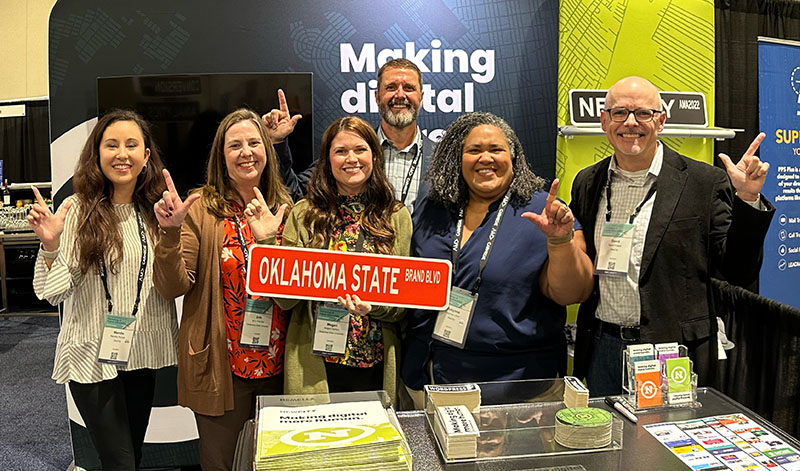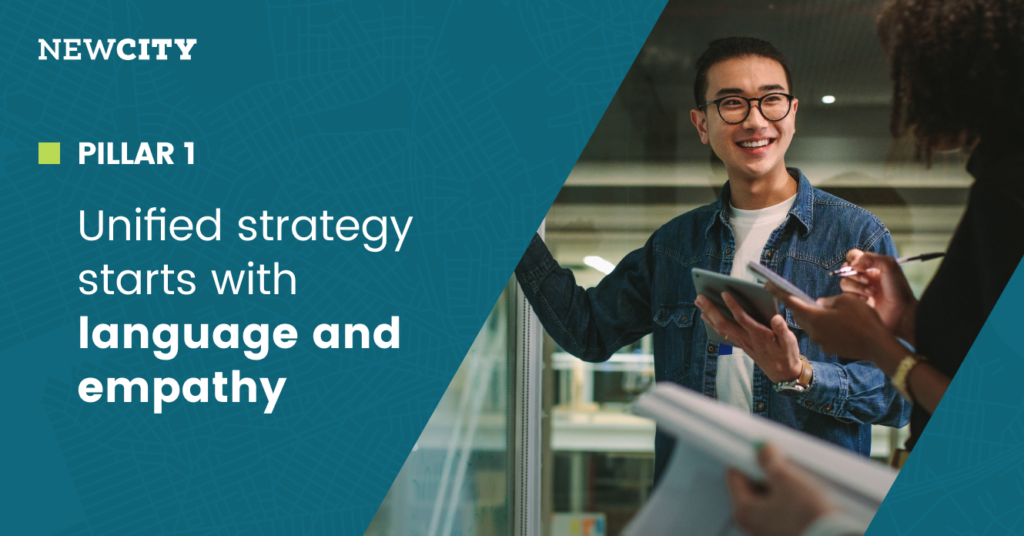In Part 1 of our Seven Pillars of Higher Ed Digital Strategy series, we make the case that creating an effective digital enrollment strategy requires enrollment, marcom and IT teams to learn each other’s internal languages and develop empathy to understand each other’s viewpoints, values and work cultures. Only then can they build a shared vision with shared goals.
When institutions instill a culture of true collaboration across organizational lines, they can achieve greater things than any of these teams could operating in their own silos. Your unified digital strategy can be the first step!
What is a unified digital strategy and what can it achieve?

Colleges and universities are complex and decentralized by nature. It’s common for organizational units to work in silos and run key operational elements like plans, budgets and staffing decisions independently. Your web presence can reflect this decentralization with multiple sites, resulting in a disjointed experience for users and lack of cohesive brand. Or, as we jokingly say, “your organizational underpants are showing.”
A unified digital strategy presents your institution and each of its parts as a cohesive and welcoming whole. It invites students on a clear, easy journey through your website(s) and marketing channels, and guides them towards well-informed decisions.
And in practice, your strategy becomes a unifying thread across units, disciplines and teams. You can use it to help achieve your goals, and also as a means to help your culture shift towards collaboration.
Oklahoma State University was one of the early leaders in forming a unified digital strategy. Megan Horton, AVP for Brand Management, and Erin Petrotta, Director of Marketing, forged an alliance in the mid 2010s to change their siloed culture. At the time Megan was Associate Director of Communications and Erin was Assistant Director of Admissions. Erin described her early experience:
When I first got to OSU, the very first thing I noticed was that our Admissions site (really our university site in general) was really awful. I'm not sure how anyone was applying to the institution, because I couldn't even find the apply button. But in the organizational structure, our web team reported up through Megan in the central university communications team. And so that's really where our relationship began, was in discussions about website issues.”
At the time, Megan’s team was midstream in a redesign and replatforming of their full website, but that wasn’t going to move fast enough to meet Admission’s needs. Megan pointed out that the editorial calendars for the central communications team, university marketing and admissions weren’t aligned. Neither were their advertising budgets.
So they chose a pilot project to pool some funds and create a shared strategy for a digital admissions campaign that involved a high level of web support. The short-term goal for the pilot was to enhance enrollment and the prospective student experience. Erin and Megan also hoped their bigger long-term goal would come to fruition – a high-level reorganization and realignment of the university’s central MarCom functions and strategies.
What’s essential in developing a unified strategy? Language and empathy.
If there’s one thing our three decades of work has taught us, it’s that a unified strategy is impossible if you don’t start with language and empathy. Here’s how that can work inside large, decentralized organizations with disparate units and teams.
Take the time to learn each other’s languages.
I need to know why the things that matter to you matter, and why they can and should matter to me.” - Robynne Lofton, Director of Enrollment Strategy, NewCity
Enrollment, marcom and IT teams come from different professional and educational backgrounds. They have different skill sets, values and work cultures. And maybe the most salient example of their differences are the languages they speak- the highly specialized and often exclusive lingo, catchphrases and acronyms of their respective work areas.
Marketing comes to the table with their metrics of site traffic, media engagement and return on advertising spend (ROAS). Enrollment talks about applicant rates, demographics and retention rates. IT thinks in terms of cybersecurity, data warehousing and help-desk service level agreements (SLAs). Each of these acronyms and metrics is important, but if they’re not decoded, they end up making everyone feel isolated.
To align around a shared vision, take the time – even multiple sessions – to teach and learn each other’s languages. Your teams will begin to understand each other’s work, the goals that motivate them, and the culture and values that make them good at their jobs. By listening to each other, teams acknowledge each other’s unique viewpoints, backgrounds and skills. And they’re laying the foundation of respect and trust that makes true collaboration possible.
Use empathy to build respect and understanding.
Empathy is a great way to forge connections with people and show them you know where they’re coming from. It’s about stepping outside of yourself and your goals, and finding where you share common ground. It’s great if you can decide that you’re both after the same thing; that at the end of the day we are here to serve students and promote higher education.” - Jessica Catto, VP of Delivery, NewCity
Creating a unified strategy can be complicated, challenging and technical. And working towards unity in general is hard. Teams are often underfunded and under-resourced which can make collaboration across organizational boundaries feel like something they don’t have time to tackle.
Empathy (the ability to share someone else’s feelings or experiences) is what will get everyone over the inevitable bumps in the road. Because when your teams are committed to this process, things can come up. Differences in opinion, frustrations over funding or resources, old grievances and more. Talking about these issues and listening to team member’s concerns will create understanding and start to break down the barriers that keep teams separated.
We’ve seen leaders who have imagined and championed a unified strategy for their schools, with remarkable results. Empathy has always been the catalyst of this change.
They challenged their people to get in the sandbox and forge alliances across teams. They listened and acknowledged each other’s viewpoints and challenges. They kept teams accountable, over-communicated and shared the credit when the project succeeded. Even when it was hard, they kept modeling empathy until the culture slowly began to shift.
Megan Horton described the impact of that growing respect and empathy at OSU:
And so early on, just like I forged a relationship with Erin, I forged relationships with other people. My web team (led by Andrew Breshears) has a really strong relationship with our Information Technology team. We had to identify the key players and work through the sensitivities. Who would be on our team through the pilot? Who would help us along the way, and make sure that we shored up those connections and brought everyone else along with us? Who can we trust?”
Consider “Executive Sponsorship”
It's especially challenging because we know that chief communications and marketing officers have a pretty rapid turnover rate. So you get on a path and then maybe there's a leadership change… and you feel like you're never going to get there.” – Jaime Hunt, VP and CMO, Old Dominion University
Especially because this process is hard, we recommend the sponsorship of a senior leader with strong diplomatic skills, to act as an internal champion. This should be a leader skilled at translating language and ideas across different domains. They can pave the path, finding resources and removing barriers to your success. When we’ve seen the process of distributed governance work well, it’s because there’s a person like this championing cross-functional alignment.
Megan and Erin didn’t start with an executive sponsor at OSU, but they were able to grow that support by demonstrating early wins from their pilot efforts. As their move to a unified digital strategy gained momentum it attracted more allies. Eventually, it led to changes in OSU’s organizational structure, with university communications, marketing, branding/digital strategy and marketing/student communications teams all reporting up to a VP of Enrollment and Brand Management.
Aligning Around a Shared Vision
Once you begin building shared language, respect, and empathy, teams can set goals with a better understanding of the ramifications of those goals for other people and the institution as a whole. They’re better equipped to take ownership of their own parts of the plan, because they realize how their work really affects the other teams.
Developing a unified digital strategy – and carrying it forward – is still a lot of work. It’s never really done. But you’re working alongside colleagues who have each other’s backs. You all realize what’s at stake, what success means to each of you, and you can rally around a shared vision of the future you’re building together.
Megan said it perfectly:
You've got to align yourself with people who share that mindset, who share your goals, and are OK with a little extra work, and will get in the trenches with you. So Erin was my ally, and I was hers, and we were in lockstep with each other. We communicated at a high level throughout this process.”

We consider ourselves very fortunate to have been OSU’s digital partner through this transformation. The relationships they built enabled them to move to a fully integrated university website including all colleges, focused around their key audiences. Leadership like Megan, Erin and Andrew’s is vital for institutions to grow, and we’re committed to elevating and encouraging it everywhere we can.
Their long-term commitment to a unified digital strategy continues to deliver results. In the fall of 2023, OSU set a new record for undergraduate enrollment, adding over 500 students (+2.6% YoY). They also saw increases across the cohorts of Honors College, new graduate students and Oklahoma’s Promise students.
These enrollment trends reflect the transformative work happening at Oklahoma State University,” OSU President Kayse Shrum said. “Last October (2022), we unveiled a strategy to reshape higher education with a student-focused approach, and we’re doing just that.”
Conclusion: How NewCity Can Help
If you are building your digital strategy on your own, we applaud you! We hope that the insights and tips you gain from this series help guide you. Should you ever need an outside partner to assist on any aspect of this work, NewCity is here. Sometimes an outside facilitator can be the key to navigating cross-functional priorities, cultures and values while steering the team toward success.
Making changes between decentralized teams can be hard. But we’ve seen it happen.
Forging relationships, decoding different languages and aligning on shared goals can help teams build effective strategies and partnerships that have the potential to turn walls into bridges.
Quotes from Megan Horton and Erin Petrotta are from their presentation at AMA Higher Ed 2018 titled “Making Change: Growing a seed in a culture of silos.”
Quotes from Jaime Hunt are from her presentation at AMA Higher Ed 2023 titled “A Roadmap for Transformation.”

